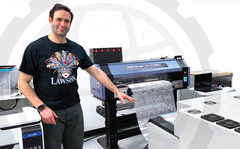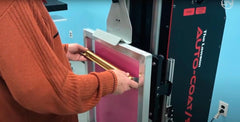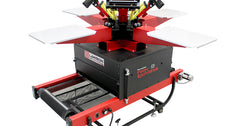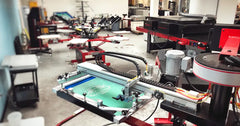3 tips and tricks for how to best layout your screen printing shop for optimal results.
Since Lawson Screen & Digital Products opened its doors in 1949, we have been helping people succeed with starting their screen printing business. The great thing about screen printing is that there are few “hard” rules. Everyone can be successful in a various ways. This allows for a lot of creativity and flexibility for setting up your business. One popular question those new to screen printing ask is how to set up your production floor, or the area you will printing. The following 3 tips and tricks for how to layout your screen printing shop apply whether you have a dedicated space or are printing out of your garage or home.
 1. Place Your T-Shirt Press in a Central Location With Room to Walk Around
1. Place Your T-Shirt Press in a Central Location With Room to Walk Around
When printing, you are going to need access to your plastisol inks and on-press chemicals. Having your manual or automatic printing press in a central location helps you print more efficiently. Being in a central location means you can quickly access everything you might need to complete your screen print job.
Also Make sure you have plenty of room to move around your t-shirt press. People often will set up their press and have to squeeze by it, or are constantly bumping against it. While this may seem fine or something you can tolerate in the beginning, it quickly gets annoying. Not being able to easily move around ends up slowing your production and causes unnecessary aggravation.
2. Keep Your Conveyor Dryer Close to Your Printing Machine
In an ideal shop set up, you’ll be able to print the last color on your silk screen printing machine and pivot in place to drop your shirt on the conveyor dryer belt. A layout like this may not be possible given your space restrictions, but try to minimize the amount of steps you take. You want to minimize the amount of space between your press and t-shirt dryer. Get the shortest possible walk to put your garment on the dryer tunnel’s conveyor belt. The more distance you cover between your printing press and dryer increases the chances of something happening to your print. The last thing you want is to accidentally have a part of your shirt touch the wet screen printing ink and uncured print.
3. Keep Your Power Source and Outlets In Mind
Most screen printing dryers require 220/230 volts.Screen printing flash units can either be 120 or 220. An all electric automatic printing press and air compressor typically requires 220 volts. Keep the locations of your power sources in mind when laying out your shop’s screen printing machines. You might need to get extension cords to power the various pieces. If so, make sure to get the proper gauge (thickness) of extension cord. The higher the amount of amps, the thicker the cord should be.
Following this basic screen printing shop layout guide will help you with the basics of getting started with your screen printing business.







